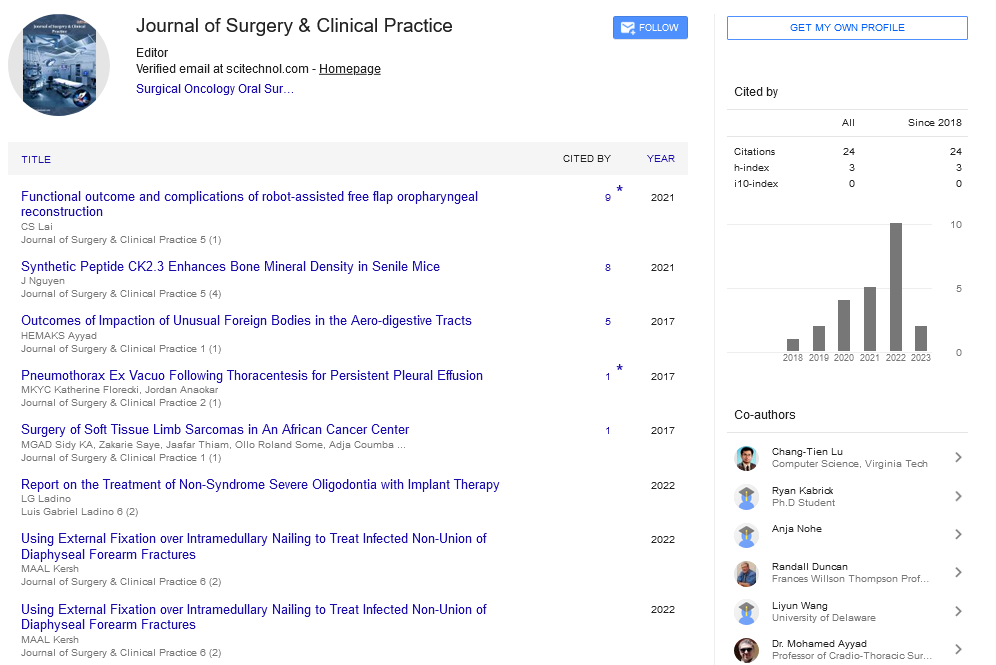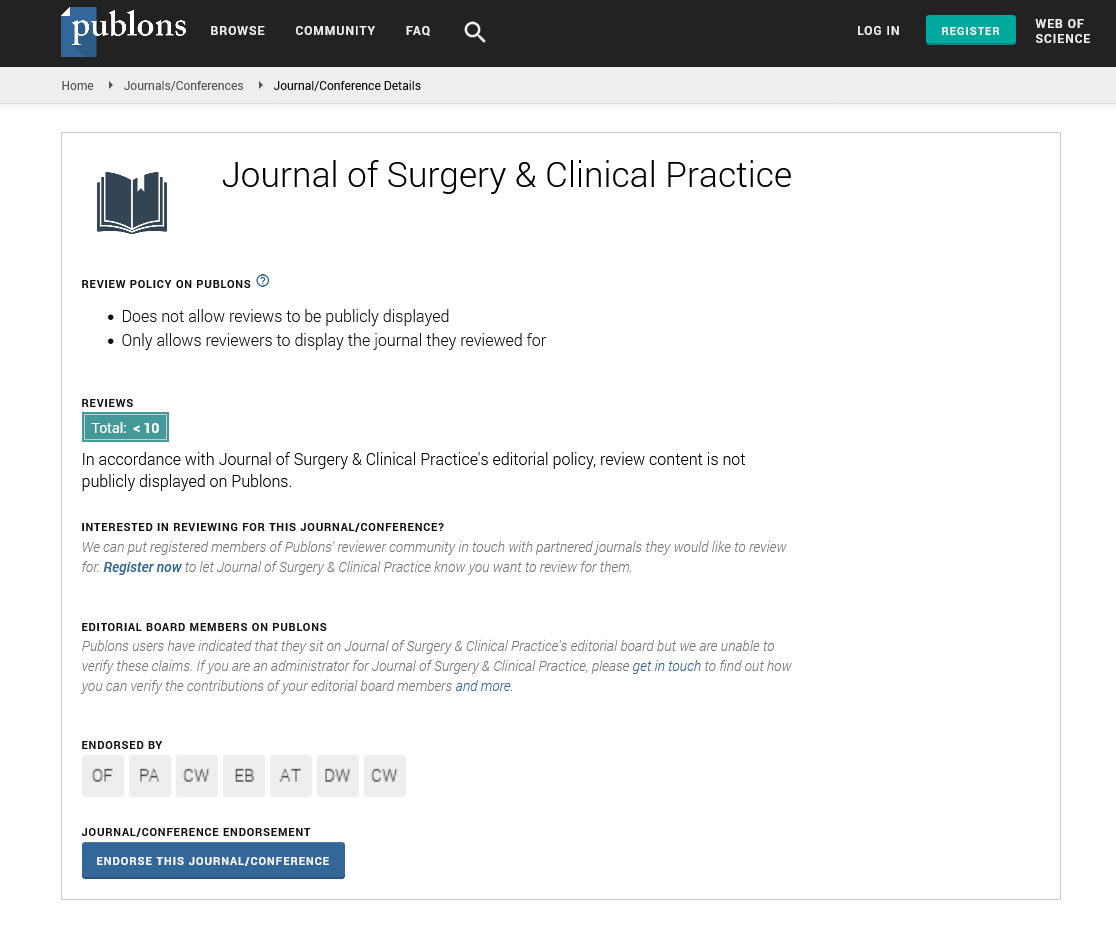Commentary, J Surg Clin Prac Vol: 8 Issue: 1
Emerging Technologies in Speech and Swallowing Disorders
Benhur Lee*
Department of Medicine, Sydney Medical School, University of Sydney, Sydney, Australia
- *Corresponding Author:
- Benhur Lee
Department of Medicine,
Sydney Medical School,
University of Sydney,
Sydney,
Australia
E-mail: benhur@surg.au
Received date: 23 November, 2023, Manuscript No. JSCP-23-120890; Editor assigned date: 27 November, 2023, PreQC No. JSCP-23-120890 (PQ); Reviewed date: 11 December, 2023, QC No. JSCP-23-120890; Revised date: 24 May, 2024, Manuscript No. JSCP-23-120890 (R); Published date: 31 May, 2024, DOI: 10.35248/JSCP.24.8.1000404
Citation: Lee B (2024) Emerging Technologies in Speech and Swallowing Disorders. J Surg Clin Prac 8:1.
Description
Speech and swallowing disorders present intricate challenges that significantly impact an individual's quality of life. In recent years, the intersection of healthcare and technology has given rise to a myriad of innovative solutions aimed at addressing these disorders. The emerging technologies that are reshaping the landscape of speech and swallowing rehabilitation, enhancing diagnostic precision, therapeutic efficacy, and ultimately, the well-being of individuals facing these challenges.
High-Resolution Manometry (HRM) has revolutionized the assessment of swallowing disorders. Unlike traditional methods, HRM captures detailed pressure measurements throughout the entire length of the pharynx during swallowing. This allows for a more nuanced understanding of swallowing dynamics, enabling clinicians to pinpoint the exact nature and location of abnormalities. Fiberoptic Endoscopic Evaluation of Swallowing (FEES) provides real-time visualization of the swallowing process through a flexible endoscope. This technology allows clinicians to directly observe the anatomy and function of the pharynx and larynx during swallowing. By visualizing potential obstructions or abnormalities, FEES enhances diagnostic accuracy and guides personalized treatment plans for individuals with swallowing difficulties.
Electromyography (EMG) in speech disorder technology is instrumental in understanding muscle activity during speech production. By placing electrodes on relevant muscles, clinicians can analyze the electrical signals associated with speech production. This information aids in diagnosing neuromuscular disorders affecting speech and guides the development of targeted rehabilitation strategies. Augmentative and Alternative Communication (AAC) devices ranging from simple picture boards to advanced speechgenerating devices, provide alternative means of communication for individuals with speech disorders. Advances in these technologies, including eye-tracking and predictive text algorithms, have significantly improved the speed and efficiency of communication for those facing severe speech challenges.
Virtual Reality (VR) therapy for speech rehabilitation is increasingly employed in speech rehabilitation to create immersive and interactive learning environments. Patients can practice speech exercises in realistic scenarios, fostering engagement and providing immediate feedback. VR therapy proves particularly beneficial in addressing social anxiety related to speech disorders. Telepractice leverages digital communication platforms to facilitate remote speech therapy sessions. This technology is invaluable for individuals who face geographical barriers or those who prefer the convenience of receiving therapy from the comfort of their homes. Telepractice enhances accessibility to speech therapy services, promoting consistent and tailored interventions.
Biofeedback devices for swallowing rehabilitation biofeedback devices offer real-time information about muscle activity during swallowing exercises. These devices, such as surface Electromyography (sEMG) sensors, provide visual or auditory cues to guide patients in performing swallowing exercises correctly. Biofeedback enhances the effectiveness of therapy by promoting targeted and controlled muscle engagement. Speech recognition technology has made significant strides, with applications extending beyond voice-activated devices. In speech therapy, these systems can analyze spoken language patterns, provide feedback on pronunciation, and offer personalized exercises to enhance articulation and fluency. Neurostimulation involves the targeted application of electrical or magnetic impulses to specific areas of the brain involved in speech production. Preliminary studies suggest that neurostimulation holds promise for enhancing speech recovery in individuals with neurogenic speech disorders, although further research is needed to fully understand its potential. Personalized Interventions: AI algorithms are increasingly being integrated into speech and swallowing therapies. These systems can analyze vast datasets to identify patterns, personalize treatment plans, and predict optimal rehabilitation strategies for individuals based on their unique characteristics and responses to therapy. While these emerging technologies offer immense promise, challenges and ethical considerations accompany their integration into speech and swallowing disorder management. Issues such as data privacy, algorithm bias, and the need for standardized protocols in the use of these technologies underscore the importance of ethical and responsible implementation.
 Spanish
Spanish  Chinese
Chinese  Russian
Russian  German
German  French
French  Japanese
Japanese  Portuguese
Portuguese  Hindi
Hindi 
